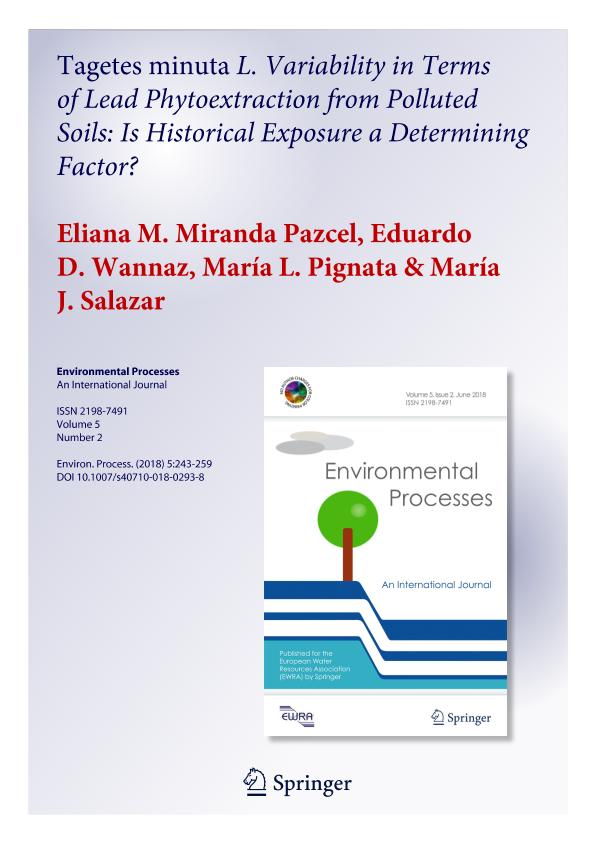Mostrar el registro sencillo del ítem
dc.contributor.author
Miranda Pazcel, Eliana Melisa

dc.contributor.author
Wannaz, Eduardo Daniel

dc.contributor.author
Pignata, Maria Luisa

dc.contributor.author
Salazar, María Julieta

dc.date.available
2019-10-21T18:04:40Z
dc.date.issued
2018-06
dc.identifier.citation
Miranda Pazcel, Eliana Melisa; Wannaz, Eduardo Daniel; Pignata, Maria Luisa; Salazar, María Julieta; Tagetes minuta L. variability in terms of lead phytoextraction from polluted soils: Is historical exposure a determining factor?; Springer International Publishing; Environmental Processes; 5; 2; 6-2018; 243-259
dc.identifier.issn
2198-7491
dc.identifier.uri
http://hdl.handle.net/11336/86667
dc.description.abstract
Tagetes minuta L. is a plant which accumulates Pb under certain conditions, making it a candidate for phytoextraction projects because it also produces marketable essential oils without detectable Pb levels. Although extraction efficiency has been shown to significantly vary between individuals, these results have been obtained using only historically exposed populations, which leads to the questions: Is the ability to tolerate and accumulate Pb a property of the species? Or is it a characteristic of some individuals from a historically exposed population? In this context, a greenhouse experiment was performed to analyse the intrapopulation and interpopulation variability in response to Pb among individuals from historically unexposed and exposed populations. In addition, we also attempted to identify relationships between certain capabilities (toleration and accumulation of Pb) and the physiological parameters related to oxidative stress or the volatile compounds of the essential oils. The Pb concentration was determined by total reflection X-ray fluorescence, physiological parameters were obtained by spectrophotometry, and essential oils were analysed by gas chromatography. The results demonstrated that adequate tolerance and accumulation capabilities are present in T. minuta, irrespective of the exposure history. These findings may be associated to a hormesis response, which includes enhancement of pigments, biomass production and the uptake of other heavy metals such as micronutrients. Nevertheless, the historically exposed population had a better tolerance to Pb, since it presented defence characteristics reflected in the essential oil composition and in the avoidance of damage at the lipid peroxidation level after Pb uptake.
dc.format
application/pdf
dc.language.iso
eng
dc.publisher
Springer International Publishing
dc.rights
info:eu-repo/semantics/openAccess
dc.rights.uri
https://creativecommons.org/licenses/by-nc-sa/2.5/ar/
dc.subject
PB POLLUTION
dc.subject
PHYTOREMEDIATION
dc.subject
TOLERANCE
dc.subject
ESSENTIAL OILS
dc.subject.classification
Otras Ciencias Biológicas

dc.subject.classification
Ciencias Biológicas

dc.subject.classification
CIENCIAS NATURALES Y EXACTAS

dc.title
Tagetes minuta L. variability in terms of lead phytoextraction from polluted soils: Is historical exposure a determining factor?
dc.type
info:eu-repo/semantics/article
dc.type
info:ar-repo/semantics/artículo
dc.type
info:eu-repo/semantics/publishedVersion
dc.date.updated
2019-10-18T18:08:43Z
dc.identifier.eissn
2198-7505
dc.journal.volume
5
dc.journal.number
2
dc.journal.pagination
243-259
dc.journal.pais
Suiza

dc.journal.ciudad
Basel
dc.description.fil
Fil: Miranda Pazcel, Eliana Melisa. Consejo Nacional de Investigaciones Científicas y Técnicas. Centro Científico Tecnológico Conicet - Córdoba. Instituto Multidisciplinario de Biología Vegetal. Universidad Nacional de Córdoba. Facultad de Ciencias Exactas Físicas y Naturales. Instituto Multidisciplinario de Biología Vegetal; Argentina. Universidad Nacional de Córdoba; Argentina
dc.description.fil
Fil: Wannaz, Eduardo Daniel. Universidad Nacional de Córdoba. Facultad de Cs.exactas Físicas y Naturales. Cátedra de Química General; Argentina. Consejo Nacional de Investigaciones Científicas y Técnicas. Centro Científico Tecnológico Conicet - Córdoba. Instituto Multidisciplinario de Biología Vegetal. Universidad Nacional de Córdoba. Facultad de Ciencias Exactas Físicas y Naturales. Instituto Multidisciplinario de Biología Vegetal; Argentina
dc.description.fil
Fil: Pignata, Maria Luisa. Universidad Nacional de Córdoba. Facultad de Cs.exactas Físicas y Naturales. Cátedra de Química General; Argentina. Consejo Nacional de Investigaciones Científicas y Técnicas. Centro Científico Tecnológico Conicet - Córdoba. Instituto Multidisciplinario de Biología Vegetal. Universidad Nacional de Córdoba. Facultad de Ciencias Exactas Físicas y Naturales. Instituto Multidisciplinario de Biología Vegetal; Argentina
dc.description.fil
Fil: Salazar, María Julieta. Universidad Nacional de Córdoba. Facultad de Ciencias Exactas, Físicas y Naturales; Argentina. Consejo Nacional de Investigaciones Científicas y Técnicas. Centro Científico Tecnológico Conicet - Córdoba. Instituto Multidisciplinario de Biología Vegetal. Universidad Nacional de Córdoba. Facultad de Ciencias Exactas Físicas y Naturales. Instituto Multidisciplinario de Biología Vegetal; Argentina
dc.journal.title
Environmental Processes
dc.relation.alternativeid
info:eu-repo/semantics/altIdentifier/url/https://link.springer.com/article/10.1007/s40710-018-0293-8?wt_mc=Internal.Event.1.SEM.ArticleAuthorOnlineFirst
dc.relation.alternativeid
info:eu-repo/semantics/altIdentifier/doi/https://doi.org/10.1007/s40710-018-0293-8
Archivos asociados
